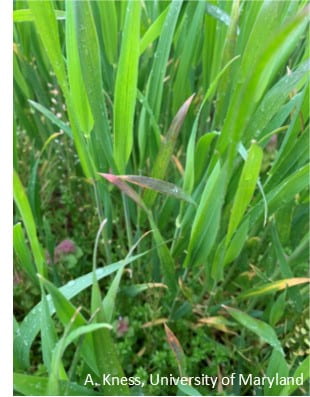Andrew Kness, Agriculture Extension Agent
University of Maryland Extension, Harford County
Over the past few weeks I have gotten questions about red/purple discoloration to barley heads (Figure 1). These symptoms are not widespread in the field; maybe 1% of heads exhibit this condition. To the best of our knowledge, these symptoms are not caused by a disease but likely a physiological response to an abiotic stress. This spring went from very mild in March to cool and even freezing in April. These symptoms could be a response to environmental conditions, genetic, or a combination of both. Affected heads appear to be viable and able to produce grain.

A second condition appearing this year is leaf burn or tip necrosis (LTN) in wheat (Figure 2). This disorder is often a response to cold injury or wind, but can also manifest as a result of heat and drought stress. These symptoms can be intensified by specific leaf rust and stripe rust resistance genes. In any case, there is nothing you can do to remedy the situation.

Leaf tip burn/LTN may be confused with barley yellow dwarf virus (BYDV). LTN tends to cause death of the leaf tip resulting in necrotic brown tissue (Figure 2), whereas BYDV can cause a range of symptoms from yellowing of the leaf, which may or may not be accompanied with bronzing/purpling of the leaf tips (Figure 3). Since BYDV is vectored by aphids, symptoms tend to be localized in hotspots in a field, whereas leaf burn and LTN more uniformly affect the entire field.

